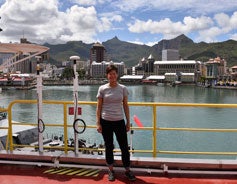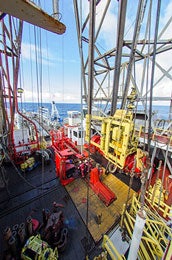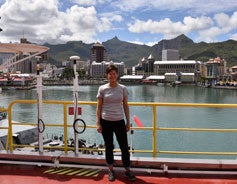 NARRAGANSETT, R.I., April 8, 2016—Imagine spending two months on a research vessel in the middle of the Indian Ocean collecting sediment at the bottom of the sea miles below.
NARRAGANSETT, R.I., April 8, 2016—Imagine spending two months on a research vessel in the middle of the Indian Ocean collecting sediment at the bottom of the sea miles below.
That’s what University of Rhode Island scientist Rebecca Robinson did as part of an international research team studying the Agulhas Current, and its influence on global climate over many years—5 million, to be exact.
The associate professor at the Graduate School of Oceanography recently returned from a research expedition with 29 other scientists on the International Ocean Discovery Program’s Expedition 361, a research group funded, in part, by the National Science Foundation.
The group sailed on the drillship the JOIDES Resolution to core deep into the ocean floor off the coast of eastern Africa to search for evidence that would explain the role of the Agulhas Current in past climate change, and how similar changes in the current might affect climate change today.
The ship operated round-the-clock, and Robinson worked in the laboratory from midnight to noon seven days a week. She slept in a bunk and ate her meals with fellow scientists. The railings on the ship’s lowest deck were wrapped with razor wire to deter pirates.
“It was a long trip, but well worth it,” says Robinson, who lives in Wakefield. “The opportunities and access to exciting new material and brilliant people made it worthwhile leaving the comforts of home.”
The sediment cores they collected provide a window into the past of the Indian and Atlantic oceans and allow the team to investigate how much warm and salty Agulhas water has entered the Atlantic over the years.
The Agulhas Current, which is hundreds of miles long and a mile deep, carries vast amounts of warm, salty water from the Indian Ocean south to the tip of South Africa.
While most of the water flow curls around to stay in the Indian Ocean, some of the water “leaks” into the Atlantic Ocean in massive swirls, known as Agulhas Rings.
Some of the warm, salty water makes its way into the North Atlantic from the Gulf Stream, where it eventually cools and sinks, carrying more water northward and creating ocean currents that influence northwest European and global climate.
Robinson and the other scientists collected more than three miles of sediment cores along the coasts of Mozambique and South Africa. They will examine the sediment to reconstruct the temperature, chemistry and flow of the oceans millions of years ago.
 They are able to do this because ocean sediments—partly made up of the fossil shells of microscopic sea life that once lived in the ocean—collect on the sea floor when they die.
They are able to do this because ocean sediments—partly made up of the fossil shells of microscopic sea life that once lived in the ocean—collect on the sea floor when they die.
Over time these sediment layers build up, allowing researchers to examine different layers for clues to the past: fossil makeup, chemical composition and physical and magnetic properties of the sediment from land.
Robinson, a geochemist specializing in the Earth’s history of the nitrogen and carbon cycles, worked in the ship’s chemistry lab measuring chemical compounds in the sediments and sedimentary pore fluids—or the water between the grains of sediment.
Robinson and the other scientists will work for the next four to six years, examining the sediment cores closely for evidence of how the Agulhas Current has influenced the regional and global climate over millions of years.
“This expedition is important because it has implications for understanding how the climate system might operate in a warming world,” says Robinson. “Five million years ago, the earth was significantly warmer—by 5 degrees Fahrenheit. Understanding how the ocean climate system operated at that time might provide us with clues as to what could happen as we face a warmer future.”
The team is also exploring the possible role that climate played in the evolution of early modern humans. The sediments collected near Mozambique rivers hold information about soil and plants on land millions of years ago where early humans lived.
“It’s great to be home, and now the fun starts with data collection,” she says. “We’ll be collecting and analyzing data and writing papers for years.”
She also plans to give a talk about the trip at her children’s schools in Wakefield. “I have pictures of albatross, whales’ tails and penguins to go along with the science photos. Who knows? The talk might inspire someone to be a scientist.”
Pictured above:
Rebecca Robinson, an associate professor at the Graduate School of Oceanography, stands on the deck of her research vessel docked in Port Louis, Mauritius, an African island nation in the middle of the Indian Ocean.
Photo by Thiago Santos.
A bird’s eye view of the rig floor of the JOIDES Resolution research vessel. Photo by Tim Fulton.
Rig floor workers from Siem Offshore using sediment cores aboard the JOIDES Resolution research vessel. Photo by Tim Fulton.

